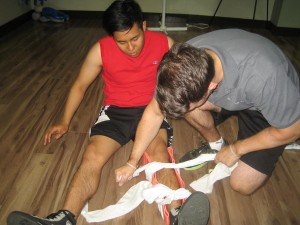
I can remember working at one of my first rugby games as Emergency Medical and Sports Responder when a 500lb man ran into a much smaller player. Even across the field we could hear the loud popping sound and the gut wrenching scream of this big strong man. This occasion was one of the most frightening experiences thus far in my career as a responder. Seeing this big man cry and all that blood was frightening. However due to our training we were able to securely immobilise and transport the patient to the hospital. It is this same knowledge that I will be imparting to you. With a few first aid courses you will able to navigate any fractures you might come up on. The femur bone is the strongest bone in the body it takes a great deal of force to crack and even more so to break it. This kind of fracture usually occurs in car accidents and contact sports such as rugby. There are four types of fracture that could occur in any of these circumstances.
1) Open Fracture
This fracture occurs when the bone pierces the skin.
2) Closed Fracture
This occurs when the skin is left unbroken.
3) Non-Displaced Fracture
This occurs when there is just a cracking of the bone
4) Displaced Fracture
This occurs when the move is unaligned but is not breaking the skin
Signs and Symptom of a femur fracture
1) Tenderness upon touch
2) Swelling around area
3) Deformity
4) Bruising
5) Guarding of affected area
6) False Motion
7) Pain
8) Exposed Fragments
9) Crepitus
This is the popping or crackling sound in joints heard upon impact.
10) One leg short then the other
Treatment
1) Due to the severity of this injury a full body check needs to be done on the patient.
2) Any force that is strong enough to break the femur may also cause damage to the c-spine area; therefore c-spine immobilization will be needed.
3) Patient should also be treated for shock.
i) Elevate uninjured leg above level of heart
ii) Remove tightly fitted clothing
iii) Wrap the patient in blankets to keep them warm
4) If it is an open fracture apply a bandage and pressure but ensure that the bandage is not so tight that it disrupts the distal circulation.
5) Ensure that the bandage is checked at intervals as it might become tight due to the swelling of the area.
6) Ensure that you check the neurovascular status of the extremities.
a) Capillary refill
(1) Press the nail bed down until it becomes pale or blanched.
(2) The colour should return in 2 seconds; if it does not it can be assume that the patient has impaired circulation.
b)Sensation
(1) Press finger against the underside of the big toe and ask the patient if he can feel it.
(2) Press finger against lateral side of the foot and repeat question.
c)Motor Function
(1) Ask patient to wiggle their toes.
7) Apply an ice pack to the swollen area.
8) Splinting
a) You need at least four persons to perform this type of splinting.
b) The first person should holding the c-spine stable
c) The second person needs to hold the leg in traction, which means pulling the leg down to its correct length and realigning the bone.
d) The last two persons will place the splints around the leg and triangular bandages will be used to strap the leg in. Ensure that the bandages are not pressing on any vital blood vessels or nerves.
e) The splinting should be done securely so as to prevent the movement of the bone which would lead to blood vessels and nerves being torn up.
f) If you have a Mechanical or Hare Traction splint please watch the video posted below for instructions.
